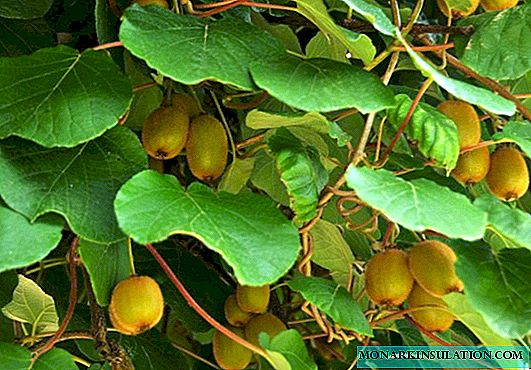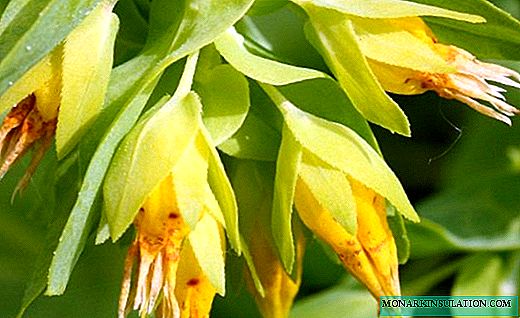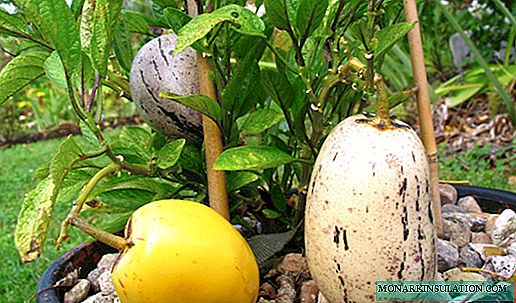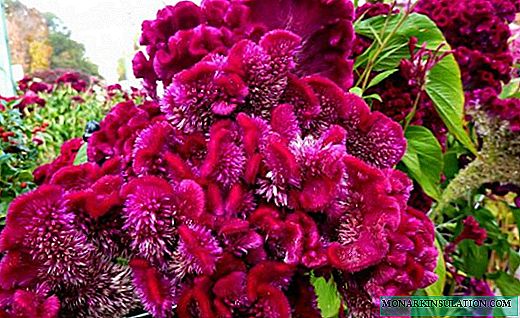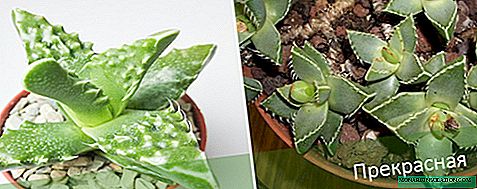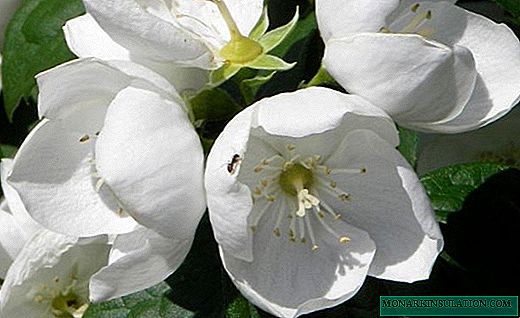Chubushnik is a sprawling deciduous shrub or shrub from the Hortensian family. Its homeland is North America, Europe and East Asia. Very often in the gardens, parks, mockwort is grown like jasmine, believing that it is the latter that grows on the site. Indeed, the aromas of the flowers of these two completely different plants are very similar. Chubushnik got its name because it made smoking pipes - chubuki - from its branches. Charming thickets covered with a delicate fragrant cloud are widely used in landscape design. Care for them is not burdensome, therefore mockwort is found in many garden farms.

Plant description
Chubushnik is a perennial with flexible spreading shoots 0.5-3 m high. The stems are covered with smooth bark, which peels off slightly. It is painted in gray-brown color. In the lower part of the branch lignify and thicken, but most of the shoot remains very thin and flexible. As a result, the bush resembles a large sprawling fountain.
On young branches, opposite petiole leaves of ovoid, oval or elongated form grow. Their length is 5-7 cm. A smooth leathery surface of dark green color is covered with longitudinal veins.
From May-June, the mock-up bush dissolves loose racemose inflorescences at the ends of young shoots and in the axils of the leaves. In one brush, there are 3-9 buds. Flowers of a simple or double shape in diameter are 25-60 mm. Their petals are painted white or boiling white. The flowers exude a very intense, sweet aroma of jasmine. Some varieties smell like strawberries or citrus. Pointed petals frame a bunch of thin stamens and a single pistil.



















Heady aroma attracts a large number of insects. After pollination, seed boxes with 3-5 nests mature. They contain very small, dust-like seeds. In 1 g of seed there are about 8000 units.
Types of mock up
In the genus Chubushnik there are slightly more than 60 species of plants. Some of them:
Chubushnik coronet. A sprawling shrub up to 3 m tall grows in Southern Europe and Asia Minor. It has flexible branched shoots covered with red-brown or yellowish bark. Dense foliage grows opposite and has an oval shape. The upper side of petiole leaves is smooth, and from the bottom along the veins there is rare pubescence. Cream flowers with a diameter of about 5 cm are collected in loose brushes at the ends of the stems. They bloom in late May and bloom for about 3 weeks. Variety resistant to frost up to -25 ° C. Varieties:
- Aureus - a shrub in the shape of a ball 2-3 m high densely covered with bright yellow leaves, which gradually turn green by summer;
- Variegata - broadly oval leaves of the shrub are painted in dark green color and bordered by an uneven cream strip;
- Innosense - a sprawling bush up to 2 m tall blooms less abundantly, but blossoms leaves with a marble pattern.

Chubushnik ordinary. Shrub with erect branched branches grows up to 3 m in height. It is covered with simple oval leaves up to 8 cm long. The loose brushes on the edges of the shoots consist of simple white-cream flowers up to 3 cm in diameter.

The mockery of Lemoine. Hybrid group, which includes more than 40 varieties of mock orange. All of them are characterized by a rich sweetish aroma. Plants form particularly dense thickets up to 3 m high. Fine bright green foliage grows on the branches. In summer, very fragrant flowers bloom up to 4 cm in diameter. Varieties:
- Chubushnik bicolor - a fluffy bush up to 2 m high, blossoms single large flowers in the axils of the leaves.
- Virgin - brown flexible shoots form a sprawling bush 2-3 m high. Oval leaves about 7 cm long with a pointed edge grow on them. Leaflets are painted in dark green color. In July, double flowers, almost devoid of aroma, bloom up to 5 cm in diameter, which are collected in a brush 14 cm long.
- Terry marshmallow - plants resistant to frost, in late June, bloom in large double flowers.
- Ermine mantle - plants 80-100 cm high are distinguished by large double flowers, the petals of which are located in several tiers.
- Bel Etoile - undersized (up to 80 cm) shrub during flowering along the entire length of the shoots is covered with large double flowers.
- Snowbel - a bush with erect shoots up to 1.5 m high at the end of June blooms fluffy flowers that look like bells;
- Mont Blanc - a large number of small semi-double flowers with a diameter of 3-4 cm blooms over thick thickets up to 1 m in mid-June.

The mock-up is hybrid. Under this name, the creations of various breeders are combined. These are decorative varieties and intraspecific hybrids. The most interesting of them:
- Moonlight - a short plant up to 70 cm high consists of reddish shoots with small bright green leaves and creamy terry flowers with strawberry aroma;
- Pearls - a low shrub with weeping reddish stems and double flowers with pearl-white petals, which reach a diameter of 6.5 cm;
- Chubushnik Shneeshturm - a bush up to 3 m high with weeping shoots blooms in early June with large terry inflorescences;
- Majori - a sprawling shrub up to 1.5 m high with arched shoots covered with dark green foliage, and at the end of June it is abundantly covered with terry, very fragrant flowers;
- Minnesota Snowflake - a slender vertical bush about 2 m high abundantly covered in small double flowers;
- Elbrus - a bush with a height of about 1.5 m blossoms simple white flowers, completely devoid of aroma.

Plant propagation
Chubushnik successfully breeds in any way. When growing plants from seeds, fresh seed material (not older than 1 year) should be used. 2 months before sowing, the seeds mixed with sand are placed in the refrigerator. In March, after stratification, they are sown in containers with leafy soil, humus, sand and peat. The soil is regularly sprayed and aerated. After 7-10 days, seedlings appear. After about 2 weeks, when the real leaves grow, seedlings dive. In May, in sunny weather, seedlings are taken outside for hardening. Put her in a shaded place. At the end of May, they land in open ground.
Cutting gardeners like the most, as it is an effective and convenient way to propagate. From May to August, you need to cut young shoots with a heel about 10 cm long. The bottom cut of the stem is treated with Kornevin and planted in a box with a mixture of garden soil and sand to a depth of 5 mm. Cuttings are covered with foil and kept on the street. They must be sprayed frequently. After only 2 weeks, each seedling will have roots.

Chubushnik breeds well also by air layers or basal shoots. Large bushes can be divided. To do this, in early spring, the plants are completely dug up and cut into dividers. With tall varieties, such propagation may require substantial physical effort. It is important to complete all spring work before the sap flow begins.
Planting and caring for a mock
Thinking about when to plant a mock orange, you need to focus on the fact that the landing is completed before the buds open. Many gardeners prefer to transplant in the first half of autumn. Well-lit, open areas are selected for the plant, since in the shade the flowers will become very small and growth will slow down.

The soil should be light and nutritious with neutral acidity. They dig the earth in 1-2 weeks, make sand, sheet soil and humus. The distance between individual plants depends on the variety and purpose. When planting, to create a hedge, the distance is 50-70 cm. A sprawling, tall bush will need up to 1.5 m of free space.
A landing pit is dug to a depth of 60 cm. A drainage layer is poured into the bottom about 15 cm thick. The root neck must be fixed on the surface of the soil or not deeper than 2-3 cm in the ground. After planting, the soil is tamped and bushes abundantly watered. Further care for mock-ups is not burdensome.
The plant usually suffers from natural rainfall and only in prolonged drought and intense heat the bushes are watered with 1-2 buckets of water once a week. The trunk circle periodically loosens and weeds are removed. Organic fertilizers are applied in the spring, after the thaw. Before flowering, mockwort is additionally watered with potassium-phosphorus compounds.

Trimming the mock-up is carried out in several stages. In the spring, frozen, dry branches are removed. Also, before the buds open, the crown is shaped. Old thickets spend anti-aging pruning. The stems are completely cut, leaving only hemp 5-7 cm high. When pruning in the fall, the forelock is sanitized. Unnecessary overgrowth and thickening shoots inside the bush are removed.
Chubushnik is very resistant to plant diseases. At the same time, a spider mite, weevil and bean aphid can attack it. Insecticide treatment can be carried out in the spring as a prophylaxis and when parasites are detected.
Garden use
The dense thickets of mock-ups are used as hedges, to design borders and near the walls of buildings. During flowering, bushes form beautiful, fragrant cascades. Low-growing species are suitable for landscaping rockeries, alpine hills and the banks of water bodies. High slender cascades will be an excellent background for a flower garden. Hydrangeas, spireas, and weigels look good next to them. In autumn, the leaves acquire a beautiful reddish-yellow color, which attracts the eyes of passers-by.


